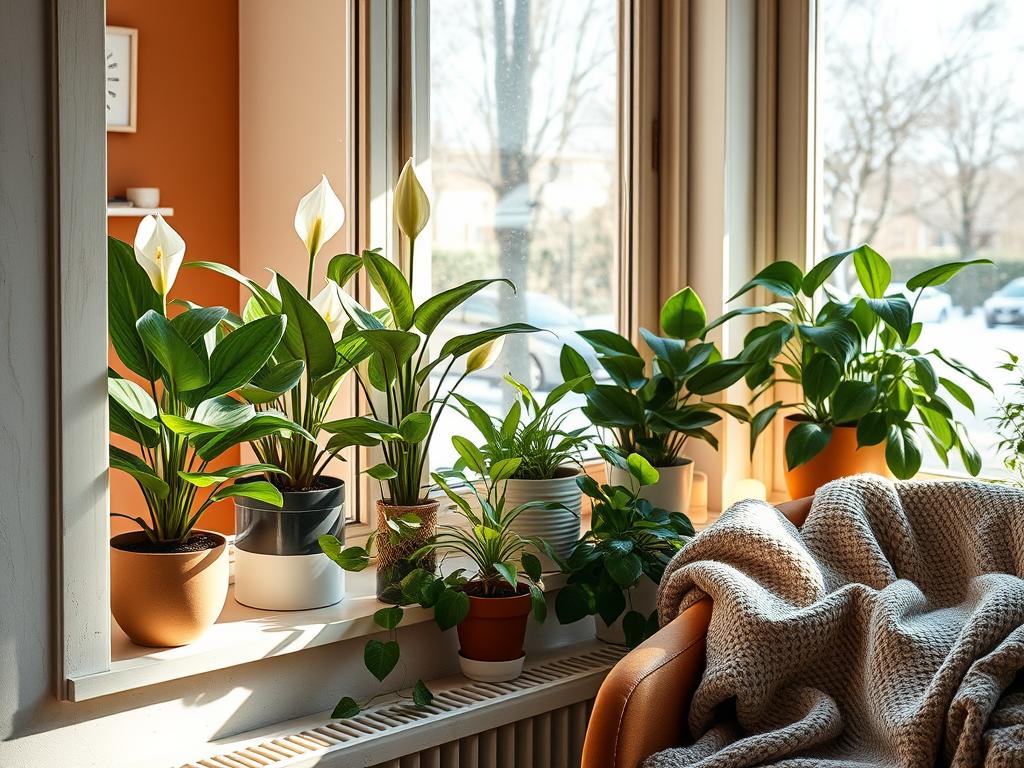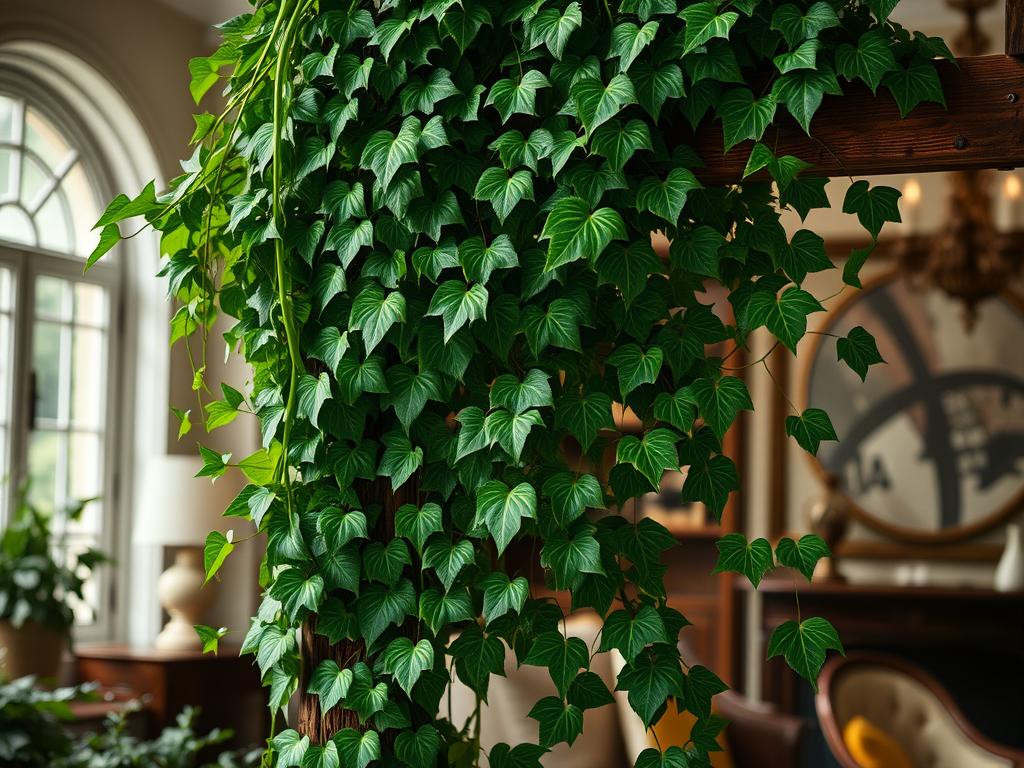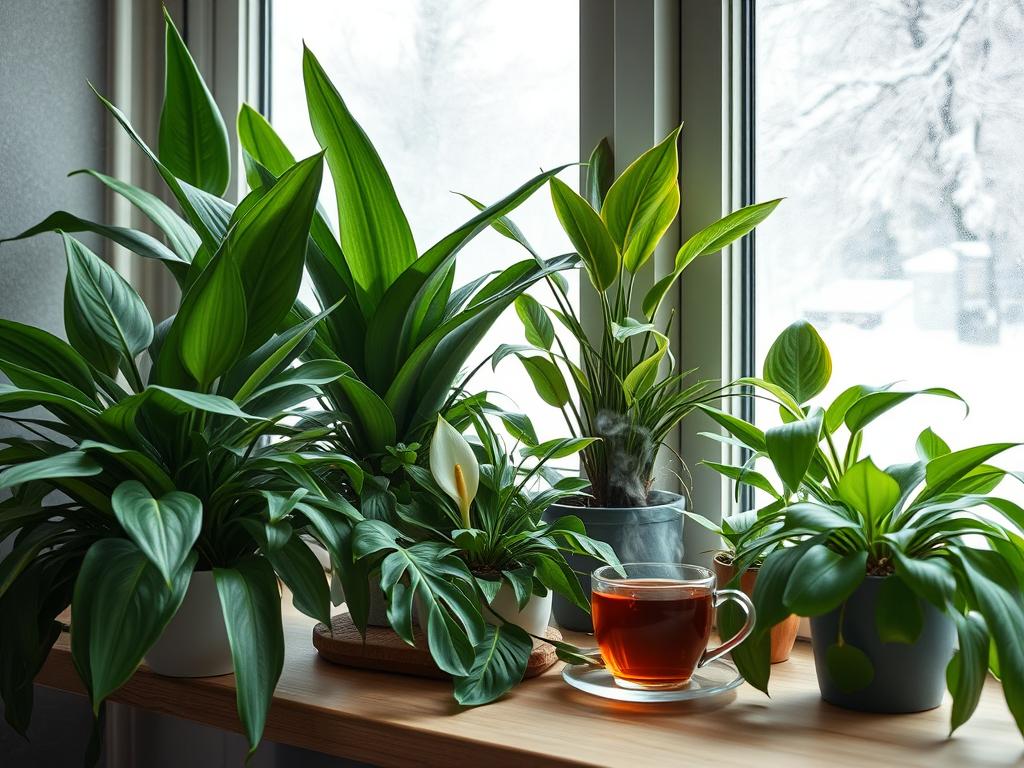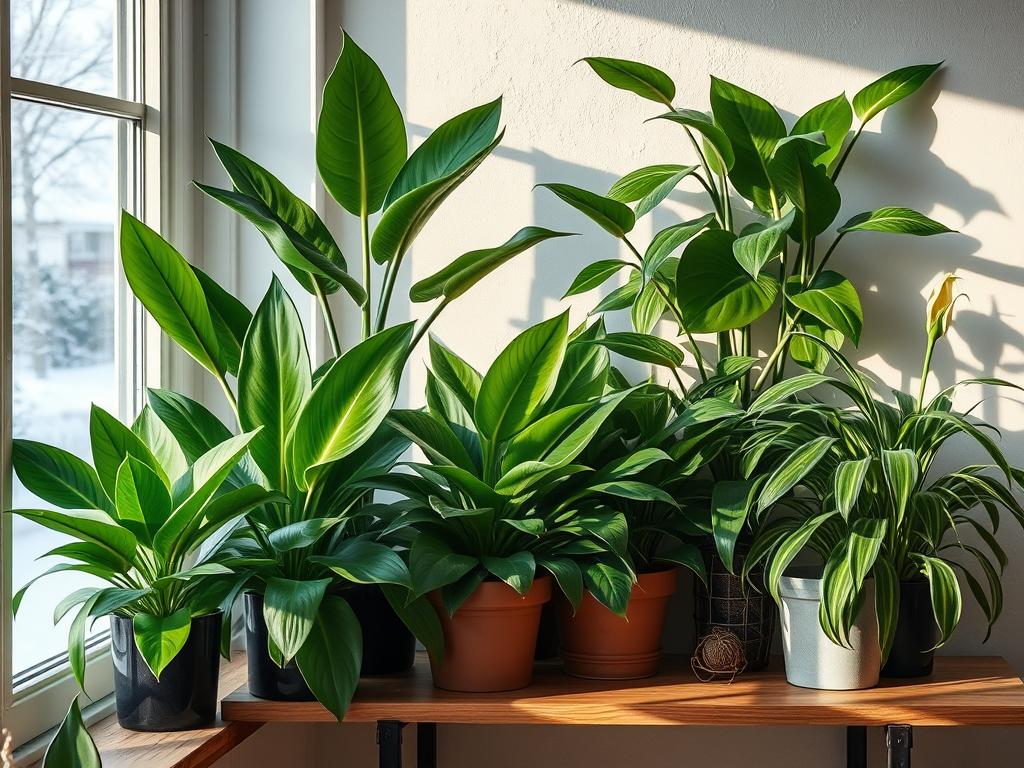Winter makes us stay inside more, but our indoor air can get worse. Indoor plants help clean the air naturally. They make our homes look better and keep the air clean.
Studies show that some plants can clean our indoor air well. At the University of Washington, scientists made pothos ivy better at removing harmful chemicals. This shows how plants can be great natural air filters.
The NASA Clean Air Study found that certain plants can clean up to 87% of toxins in a day. This proves how important it is to have air-cleaning plants in our homes. By picking the right plants, we can make our homes healthier during winter.
Key Takeaways
- Indoor plants can significantly improve air quality during winter
- Some plants can remove up to 87% of air toxins in 24 hours
- Pothos ivy has been modified to target specific air pollutants
- NASA research supports the air-purifying abilities of certain plants
- Incorporating air-purifying plants can create a healthier home environment
Understanding Indoor Air Quality in Winter
Winter brings unique challenges to indoor air quality. As you spend more time indoors during colder months, you’re exposed to various pollutants. These pollutants can affect your health. Let’s explore the common indoor air pollutants and their effects on your well-being.
Common Indoor Air Pollutants
During winter, your home can harbor several types of air pollutants:
- Particulate matter (PM10 and PM2.5)
- Volatile Organic Compounds (VOCs)
- Carbon monoxide
- Nitrogen dioxide
- Mold spores
VOCs are common and come from paints, varnishes, and cleaning supplies. Fireplaces and wood stoves also release pollutants into your living space.
Effects of Poor Air Quality on Health
Poor indoor air quality can lead to various health issues:
- Headaches and eye irritation
- Respiratory conditions
- Reduced lung capacity
- Increased risk of allergies
Long-term exposure to indoor air pollution may cause more serious health problems. This shows why clean air in your home is so important.
Importance of Air Purification During Winter
Air purification is key in winter when homes are sealed to keep warm. This traps pollutants inside, making indoor air quality worse. Using air-cleaning plants can help remove harmful substances like formaldehyde and benzene. By improving your indoor air quality, you make a healthier space for you and your family during winter.
How Plants Purify Indoor Air
Plants are nature’s air purifiers, quietly working to clean the air we breathe. They play a crucial role in making our indoor spaces healthier. By purifying the air, they help us breathe easier.
The Science Behind Plant Air Purification
Plants take in carbon dioxide and release oxygen through photosynthesis. But they do more than that. They also absorb harmful chemicals from the air and break them down in their roots. This makes them natural air filters.
NASA Clean Air Study Findings
The NASA Clean Air Study in 1989 showed how powerful plants are as air purifiers. The study found some plants can remove up to 87% of air toxins in just 24 hours. NASA suggests having one healthy plant in a 6 to 8-inch container for every 100 square feet of space.
Efficiency of Plants as Natural Air Filters
While plants are great at cleaning the air, they need to be in large numbers to make a big impact. To match NASA’s results, you’d need about 680 plants in a typical home. But even a few plants can still make the air cleaner and the environment healthier.
| Air Pollutant | Source | Effective Plants |
|---|---|---|
| Formaldehyde | Wood products, furniture, fabric treatments | Spider plants, Peace lilies |
| Benzene | Paints, plastics, tobacco smoke | English ivy, Chrysanthemums |
| Trichloroethylene | Adhesives, paint removers, spot removers | Dracaenas, Rubber plants |
Top Air-Purifying Plants for Winter

Looking for the best air-purifying plants for your home this winter? Winter houseplants not only brighten up your space but also clean the air. NASA’s 1989 study showed that some plants can remove harmful toxins from indoor air. This makes them great for improving air quality when it’s cold and we’re stuck inside.
Experts say you need 2-3 plants per 100 square feet for the best air purification. Here are the top winter houseplants that are both effective and easy to care for:
- Spider Plant: Removes formaldehyde and xylene
- Peace Lily: Eliminates benzene and trichloroethylene
- Snake Plant: Filters out benzene, formaldehyde, and toluene
- English Ivy: Tackles carbon monoxide, benzene, and formaldehyde
- Pothos: Cleans air of various pollutants
These plants are perfect for anyone new to indoor gardening or those with little time. They do well in the cold months and need little care. For instance, snake plants can live for years with the right care. Pothos vines can grow long, adding beauty to your space.
| Plant | Air-Purifying Benefits | Care Level |
|---|---|---|
| Spider Plant | Formaldehyde, xylene | Easy |
| Peace Lily | Benzene, trichloroethylene | Moderate |
| Snake Plant | Benzene, formaldehyde, toluene | Very Easy |
| English Ivy | Carbon monoxide, benzene, formaldehyde | Moderate |
| Pothos | Various pollutants | Easy |
Adding these air-purifying plants to your winter decor makes your home healthier and more beautiful. Enjoy the beauty of nature all year round.
Spider Plants: The Versatile Air Cleaner
Spider plants, known as Chlorophytum comosum, are great for cleaning indoor air. They’re easy to take care of and add greenery to your space. Plus, they work hard to make the air you breathe cleaner.
Benefits of Spider Plants
Spider plants are great at removing bad pollutants from your home. NASA found they can clear up to 95% of harmful chemicals in just 24 hours. They filter out toxins like formaldehyde, xylene, and carbon monoxide, making your air cleaner.
- Effective air purification
- Removal of harmful toxins
- Aesthetic appeal
- Safe for pets
Care Instructions for Spider Plants
Looking after spider plants is easy, making them perfect for anyone. They can grow well in many places and need little care to thrive.
| Care Aspect | Instructions |
|---|---|
| Light | Semi-sunny to shady spots |
| Watering | Every 7-10 days |
| Soil | Well-draining potting mix |
| Temperature | 60-75°F (15-24°C) |
| Humidity | Average room humidity |
Spider plants are great for improving indoor air quality, especially in winter. They’re easy to care for and very versatile. This makes them a top choice for anyone looking for low-maintenance houseplants.
Peace Lilies: Elegant and Effective
Peace lilies, known as Spathiphyllum, are top choices for cleaning indoor air. They bring elegance to your home and work hard to purify the air you breathe.
NASA’s Clean Air Study shows peace lilies are great at removing pollutants. They take out formaldehyde, benzene, and carbon monoxide from the air. This makes them a great addition to any room.
Peace lilies are flexible with light, doing well in low-light spots. They’re ideal for darker corners of your home. For the best growth, put them in a spot with indirect sunlight.
| Care Aspect | Recommendation |
|---|---|
| Watering | Once weekly, 1 inch of water |
| Temperature | 64 – 84°F (18 – 29°C) |
| Humidity | 60% – 80% |
| Soil | Moisture-retaining houseplant mix |
| Fertilizer | Balanced water-soluble or slow-release |
Peace lilies are easy to care for and can grow up to 16 inches tall. They like cool temperatures and regular watering. Make sure to repot them when they get too heavy or have trouble getting water, as they do best when a bit root-bound.
Adding peace lilies to your indoor garden means cleaner air and natural beauty all winter.
English Ivy: A Classic Air Purifier
English ivy, known as Hedera helix, is a top pick for cleaning indoor air. It’s not just pretty; it works hard to make the air you breathe cleaner.

Air-cleaning Properties of English Ivy
English ivy is a star in air purification. NASA’s Clean Air Study showed it removes harmful stuff from the air. It can clear up to 87% of toxins in a day. It’s great at getting rid of benzene, formaldehyde, and pollutants from cleaners and furniture.
Ideal Placement and Care Tips
Put your English ivy in spots with soft to medium light. It likes cool temperatures, 60-65°F, which is great for winter. Water it when the soil is dry, and spray its leaves with water weekly to keep pests away.
Feed it once a month in spring and summer to help it grow strong. In spring, move it to a pot that’s 2 inches bigger to let it spread out.
Adding English ivy to your home means you’re choosing a plant that makes air cleaner and your living space healthier.
Snake Plants: Low-Maintenance Air Purifiers
Snake plants, also known as sansevieria, are great for cleaning indoor air. They are perfect for busy people who want clean air without much work.
Unique Features of Snake Plants
Snake plants are amazing at cleaning the air. They can remove up to four toxins, like benzene and formaldehyde. In just 48 hours, they can purify the air from common pollutants.
The Golden Snake Plant is a standout. It removes over 50% of air pollutants in 24 hours. These plants work best at night, making them perfect for bedrooms. They release oxygen while you sleep, helping you breathe better.
Best Practices for Snake Plant Care
Caring for snake plants is easy. They can grow in various light conditions but prefer 5-6 hours of sunlight a day. These plants can survive 2-6 weeks without water, needing less in winter.
| Care Aspect | Recommendation |
|---|---|
| Temperature | 70°F – 90°F |
| Soil | Sandy, well-drained |
| Watering | When soil is completely dry |
| Sunlight | 8-10 hours indirect |
| Fertilizer | Twice yearly, balanced 10-10-10 |
Remember, snake plants are toxic to pets. Keep them away from curious cats and dogs for a safe, clean-air home for everyone.
Pothos: The Hardy Air Cleaner
Pothos, also known as Epipremnum aureum, is a great choice for cleaning indoor air. It’s often called devil’s ivy because it’s easy to care for and removes pollutants from your home. This plant is perfect for both new and experienced plant lovers.
Pothos is great at removing indoor toxins. It gets rid of formaldehyde, xylene, and benzene, helping keep your air clean during winter. Its ability to grow in various lights makes it a favorite in North American homes.
This plant is easy to take care of. Water it when the top inch of soil is dry, which is usually every 7-10 days. Pothos can handle low light, humidity, and temperature, making it ideal for those who want low-maintenance gardens.
| Pothos Variety | Leaf Characteristics | Light Preference |
|---|---|---|
| Golden Pothos | Green with yellow variegation | Low to bright indirect |
| Marble Queen | Heavily variegated white and green | Moderate to bright indirect |
| Neon | Bright, lime-green leaves | Moderate to bright indirect |
| Jade | Solid green leaves | Low to moderate |
But, remember that pothos can be toxic if eaten in large amounts. So, be careful if you have pets or young kids at home. With the right care and spot, pothos can be a lovely and useful part of your indoor air cleaning plan.
Indoor Plants for Purifying Air During the Winter Months
Winter brings challenges for indoor gardening and air quality. The cold weather affects your air-purifying plants. They need special care to keep working well.
Seasonal Considerations for Air-Purifying Plants
Winter’s less sunlight and dry air can stress your plants. Here are some tips to keep them healthy:
- Use grow lights to supplement natural light
- Group plants to create a humidity-boosting microclimate
- Place a humidifier nearby to combat dry air

Adapting Plant Care Routines for Winter
Change your indoor gardening tips for better air quality in winter:
| Plant Care Aspect | Summer Routine | Winter Adjustment |
|---|---|---|
| Watering frequency | 2-3 times per week | Once a week or less |
| Light exposure | Natural sunlight | Supplement with grow lights |
| Humidity level | 40-60% | Use humidifier to maintain 40-50% |
| Fertilizing | Monthly | Every 6-8 weeks or pause |
By changing your care routine, your plants will keep purifying your air all winter.
Dracaena Varieties: Diverse Air-Cleaning Options
Dracaena plants are great for cleaning the air in your home. They come in over 100 species, each with its own look and size. Whether you want a tall Corn plant or a small Lucky bamboo, there’s a dracaena for you.
The Dragon tree has leaves that look like fountains, and the Song of India has leaves with stripes. If you want plants that clean the air, try the Janet Craig or Lemon Lime dracaenas. They’re good at removing pollutants like formaldehyde and benzene.
| Dracaena Variety | Height | Light Preference | Key Feature |
|---|---|---|---|
| Corn Plant (D. fragrans) | Up to 6 feet indoors | Bright, indirect light | Tall, tree-like appearance |
| Dragon Tree (D. marginata) | 2-10 feet | Medium to bright light | Thin, grass-like leaves |
| Lucky Bamboo (D. sanderiana) | 1-3 feet | Low to medium light | Can be trained into shapes |
| Janet Craig (D. deremensis) | 4-6 feet | Low to bright indirect light | Excellent air purifier |
Dracaenas are easy to care for. They like bright, indirect light but can handle low light too. Water them just enough so the soil gets dry between waterings. They do well in temperatures between 60°F and 75°F, making them perfect for most homes.
Even though dracaenas clean the air well, they can be harmful to pets. Keep them away from cats and dogs to keep your home safe and clean.
Bamboo Palm: Tropical Air Purifier
The bamboo palm, known as Chamaedorea seifrizii, is a top choice for cleaning indoor air. It adds a tropical feel to your home and helps purify the air.
Air-purifying capabilities of bamboo palm
Bamboo palms are great at removing pollutants from your home. They get rid of harmful substances like formaldehyde, benzene, and carbon monoxide. NASA found them to be among the best plants for cleaning the air. To get the most benefits, put one plant in every 100 square feet of space.
Creating an ideal environment for bamboo palms
To keep your bamboo palm healthy:
- Choose a shaded spot with indirect sunlight
- Maintain high humidity levels
- Use well-drained organic soil
- Water regularly to keep soil evenly moist
Bamboo palms can grow up to 10 feet tall, making them ideal for big areas. They do well outdoors in zones 8-11 and on patios in zones 4-7. These plants bring a tropical look to your home and keep the air clean all year.
Gerbera Daisies: Colorful Air Cleaners
Gerbera daisies are more than just beautiful flowers. They can grow up to 5 inches wide and are great at cleaning the air. NASA found in 1989 that they can cut down airborne formaldehyde, benzene, and trichloroethylene by a lot in just 24 hours.
These flowers are great at removing harmful chemicals from the air. They do well in temperatures between 40°F and 70°F, perfect for indoor spaces in winter. To keep them healthy, give them 6 hours of sunlight a day and water them every 3 to 5 days.
Gerbera daisies also help reduce stress and make people happier in offices. With the right care, like fertilizing monthly in spring and summer, they can bloom for 2 to 3 years. This means they keep your space bright and clean the air you breathe.
FAQ
Why is it important to purify indoor air during the winter months?
In winter, homes are sealed to save heat, trapping pollutants inside. These pollutants can build up without good ventilation. This makes air purification key.
How do indoor plants help purify the air?
Plants take in carbon dioxide and give out oxygen. They also clean the air by breaking down harmful chemicals like formaldehyde and benzene.
What did the NASA Clean Air Study find about the air-purifying abilities of plants?
The 1989 NASA study showed plants can remove up to 87% of pollutants in a day. But a 2019 study found a lot of plants are needed for best results.
Which indoor plants are best for purifying air during the winter?
Great air-cleaning plants for winter include spider plants, peace lilies, and English ivy. Also, snake plants, pothos, dracaena, bamboo palm, and gerbera daisies are good choices.
How can I ensure my air-purifying plants stay healthy during the winter?
Change your plant care for winter. Water them less since they need less moisture. Use grow lights and humidifiers to help them.
Grouping plants can also boost humidity and air quality.
Are there any potential drawbacks to having air-purifying plants indoors?
Most air-cleaning plants are safe, but some can be harmful to pets. Keep plants like spider plants and English ivy away from pets.
